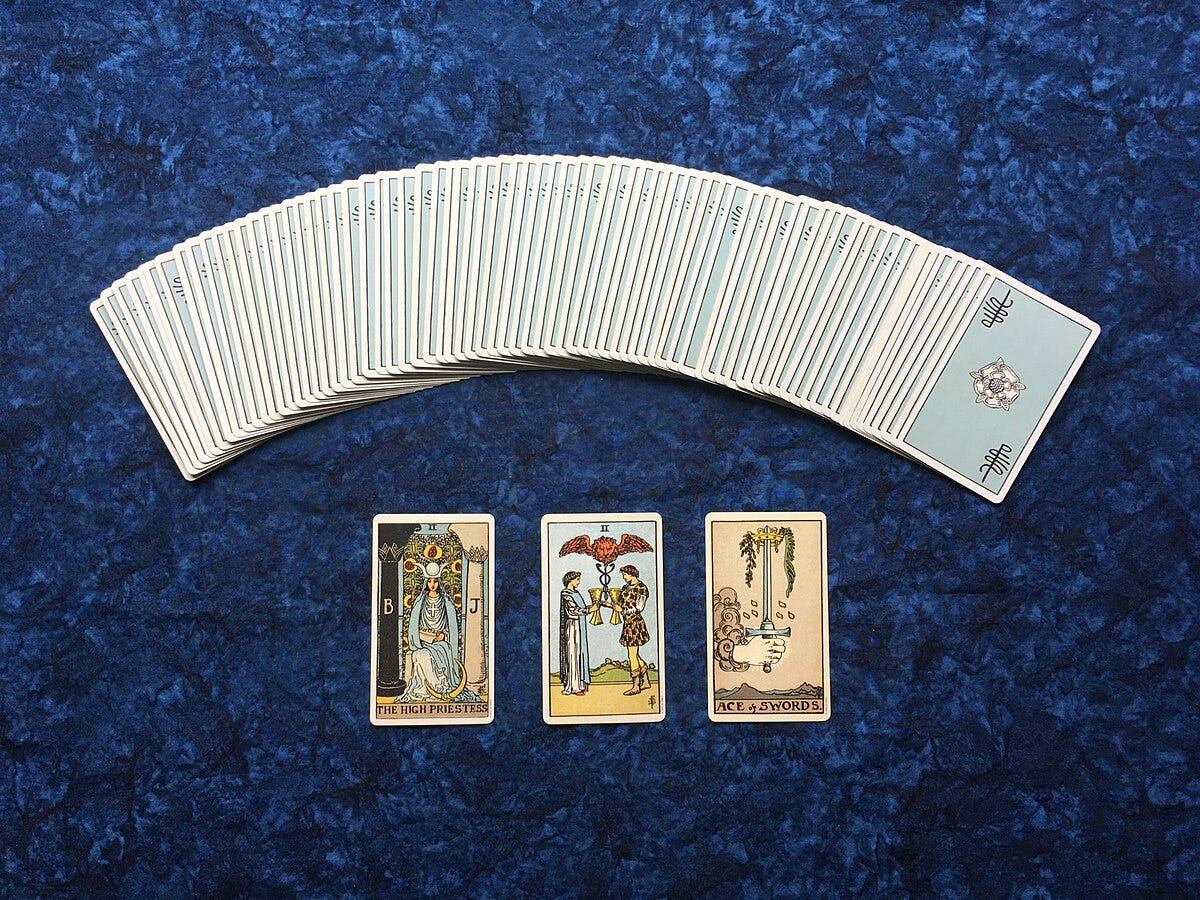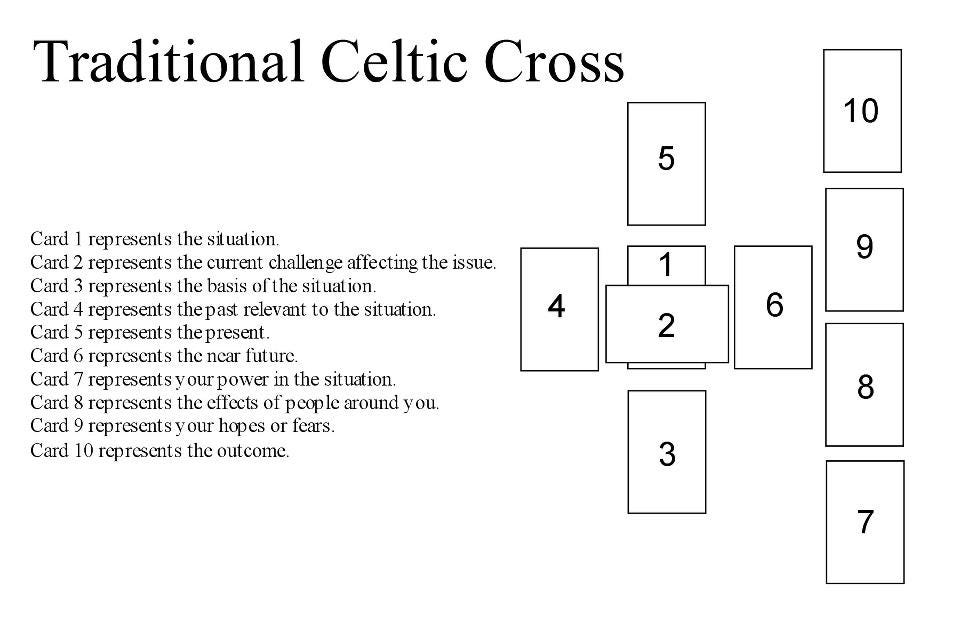Self Healers Summer Week Five: How To Do a Tarot Spread
And How To Create Journaling Breakthroughs From Them
Welcome to week five of my Substack Series: Self Healers Summer. We’ve got just one more week after this! The middle part of summer break I’ve been experiencing as going so much faster as the first part. What about you? I feel like my husband and I were just yesterday planning for a 4th of July cookout! If you missed any of the posts in this summer series, I’ve set up a link at the top of the page where this series and future posts about tarot can live permanently so you can find them quickly when you want to!
You can find all the previous posts in the series there now as well to access anytime.
What is a Tarot Spread?
Today I wanna teach you about “spreads” which is just the term for pulling a series of cards to get clarity or guidance (remember in Tarot for Reclamation our perspective is that the guidance is coming from our own inner wisdom, you could call it highest self, divine self, conscious, God, whatever you like) on an issue or situation.
This is how I use tarot in my life as a journaling process and how I’ve taught dozens of other people to use it. Spreads help you put a framework around an issue so you can get to the bottom of it.
If you google “tarot spreads” or search social media with that same hashtag, you’ll find countless examples. There are traditionally used ones with common names and then there are also ones made up on the spot or created around certain seasons, themes, or struggles. There’s not a wrong answer here. You can’t do a spread “wrong”. You could use pre-created ones that I show you here or that you find online, or you could create your own.
The most important aspect of a spread is the intention.
With tarot spreads, whether you are pulling a single card or ten, you find more clarity and less confusion. Having a question in mind as you shuffle and pull helps you to have a framework for reading the cards.
(Avoid yes or no questions with tarot. There are no cards in the deck that mean “yes” or “no” and while some people will hack this by adding their own “rules” like even numbered cards mean yes, odd means no, it’s not advised for this style of reading cards to use the cards this way. That bypasses all the symbolism and archetypal imagery that unconscious mind loves so much and if you’re using tarot for reclamation like I’m teaching, that won’t work the way you are wanting.)
Instead, come with a more open ended question.
Instead of: Will I get the promotion at work?
Try: What energy can I be aware of within myself regarding the possible promotion?
Or: What are the aspects affecting the possible promotion?
Or: What should I be aware of as I work towards this promotion?
Make sense?
There are lots of different spreads from simple to complex. Next week I’ll close out our series by showing you how I read cards “in a sentence” which has been the single most beneficial thing I started doing that took my self-reflective practice using tarot from kind of helpful and interesting to 🤯🤯🤯
Popular Tarot Spreads
Some basic popular spreads:
The One Card Spread (for focused questions or a general vibe)
3 Card Spreads (versatile but commonly follow a past, present, future orientation)
The Celtic Cross (to examine all aspects of a situation)
These three spreads give you enough options to keep you busy for a while so we’ll start here and you can play around from this foundation.

One Card Spreads: As simple as they sound. You shuffle your deck and you can either pull the card off the top or select a card from within the deck.
Starting with pulling just one card is a simple way to begin getting used to using tarot cards as journaling prompts. Some easy ways to start would be to come to the deck with the intention of: “What should I know for today?” or “What energy do I need to be aware of today?” or “What is the theme of today?”
You could also come with a very specific and focused question like “what is the main thing I need to know about (insert situation)”.
Three Card Spreads: Three card spreads are the most commonly used I’ve found because they are quick and easy to interpret and also so very customizable! Popular versions are doing a Past, Present Future spread. But one that I love a lot as well is for situations that feel stuck I’ll do a Situation, Obstacle, Solution spread. Another really beautiful version especially for our journaling purposes is The Accept, Embrace, Let Go spread.
In multiple cards spreads the card in the 1 position would represent the answer or insight for whatever the assigned aspect is (see possible examples in the column under it in the graphic). Same for position 2 and 3 and so on for larger spreads.
This gives you a lens to be viewing the card through which helps mind to pierce through the noise and see connections and truth faster. Your mind will bring to the surface what you are meant to see from it. Trust your intuition. And if that’s challenging for you, remember this is a practice. You’ll get better and better the more you do it!
The Celtic Cross: This traditional spread you will find with tons of variations online but at it’s root, it is a 10 card spread meant to highlight all the various aspects of a situation. The cool thing about the celtic cross is that you can come to it with a very specific situation you want insight into OR without a super specific question. You could use this for an upcoming month or season without having a specific situation you’re asking about. (You could do a Celtic Cross spread at the beginning of each month if you wanted!) I love the bigger spreads myself because I find that they give me the most space to uncover truths and wisdom within myself. But if this many cards overwhelms you, that’s okay, start with a simpler 3 card spread.
As I get ready to launch my new business a possible way I might use the Celtic Cross would be if I was feeling any stuckness or resistance or fear. I might say “What is holding me back from posting?” or “Why am I afraid of putting this out into the world” Those would be ideal for a Celtic Cross spread to really dig into the various aspects and have lots of cards to get to spark wisdom from deep inside.
The way that I do this in my journal is I’ll write down a list just like in the graphic above of what each card represents. Then I do my spread, flip the cards over and I go one by one through them writing down each card and the aspects of it’s traditional meaning I find useful to my situation. Then I’ll let my mind run free and free write a few sentences about what comes up for me as I look through that specific lens. Then I repeat that for each card.
At the end I put the entire thing together into a sentence which I’ll show you how to do next week.

You can ritualize this as much or as little as feels right to you. One of my students has created a little meditation space in her home with a coffee table that she always does her spreads on. She decorated it with candles and crystals and has her journal there.
Another student of mine sits in a big cushy chair with a side table and no additional elements. She pulls one card at a time without laying them out into a big spread and just writes as she goes.
This doesn’t have to be a whole production if you don’t want it to be. In fact, thinking that you need everything to be perfect, or super witchy, can potentially stand in the way of you just getting started so don’t let your mind convince you that you need your setting to be any specific way.
Some elements that are useful though would be:
A comfortable spot
Quiet or being left alone so you can think and write without interruption
A journal and pen or computer/tablet to flush out your thoughts on
Everything else is extra and is optional.
Journaling Prompts of the Week:
This week I want you to practice putting these elements together.
Set an intention
Choose a framework (aka a spread)
Pull cards (or use a random digital card puller like this website) and then look up their meanings (the booklet that came with your deck or the website biddytarot.com are wonderful for this. I often will google the name of the card and biddy tarot when I want to look something up quickly)
Write out what comes up for you as you look through the lens of the what each card in a spread represents and the intention you started with.
Let me know in the comments if you get stuck and need help making sense of things! If you have any amazing aha moments I’d love to hear!
Thank you for being one of my subscribers, I appreciate you so much! If you’d like to support my work you can do so by:
‘Hearting’ this post, so that others are encouraged to read it
Leaving a comment
Sharing this post by email or on your social media
Upgrading to a paid subscription here on Substack
Checking out my website to see if working together would be something that helps you in your healing journey. Or send my info to a friend who might benefit from my work.
Becka Robinson’s (she/her) degree is in Psychology. She is a Certified Consulting Hypnotist and is trained in mimetic modalities as a way to facilitate healing from traumas both big and small. She grew up in pentecostal evangelical christianity and even served on staff in ministry before leaving at the age of 22 and has been deconstructing and sharing about it ever since. She is a neurodivergent, late blooming queer, artistpreneur and healer living in Central Florida with her husband and two kids pioneering utilizing RRT for people healing from religious trauma and reclaiming their power and agency. You can read more about her work via her website: www.beckarobinson.com. Thank you for being here.







